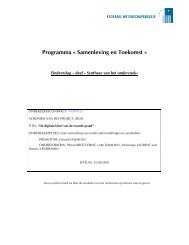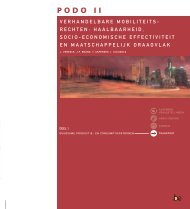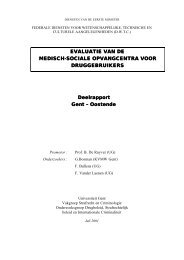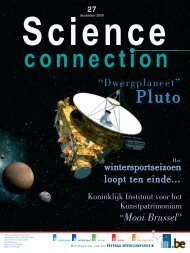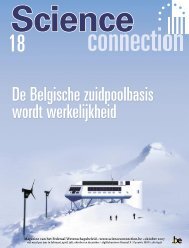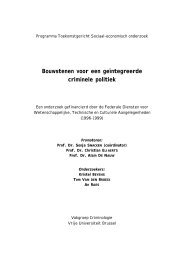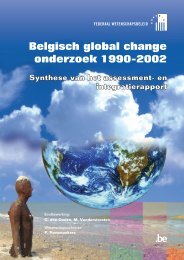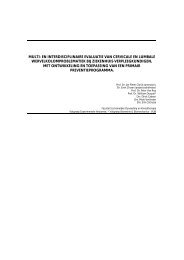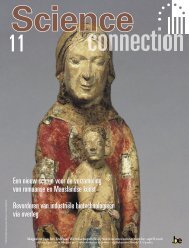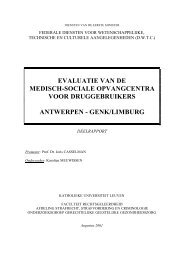chapter 3 inventory of local food systems
chapter 3 inventory of local food systems
chapter 3 inventory of local food systems
Create successful ePaper yourself
Turn your PDF publications into a flip-book with our unique Google optimized e-Paper software.
Project CP/59 - “Instruments and institutions to develop <strong>local</strong> <strong>food</strong> <strong>systems</strong>”<br />
farmers markets have different histories: either they are governed by a <strong>local</strong><br />
action group, connected to the village whereas in other cases farmers themselves<br />
rule the market. Part <strong>of</strong> them is really strict on selling only own produce, while in<br />
other cases, the difference with a conventional market is hardly noticeable.<br />
Classic farmers markets give producers the opportunity to sell directly to the<br />
consumer without any middlemen, being in direct contact with consumers and<br />
other producers. We selected three fruit producers, selling altogether on eight<br />
different markets, representative for the different present properties on farmers<br />
markets.<br />
Fourth, to get data from LFS, we choose for a multiple case study approach, combining<br />
in-depth interviews and questionnaires. The list <strong>of</strong> interview questions was composed in<br />
relation to the selected parameters. In a team <strong>of</strong> two researchers, in-depth interviews<br />
where done on location. Throughout those interviews, a space <strong>of</strong> trust evolved: a<br />
resulting open dialogue provided additional information. As the addressed individuals<br />
were given free space to talk, the generated information has been handled as essential in<br />
the data processing, especially with regard to social impacts. Additionally, network<br />
mapping was performed with all members <strong>of</strong> the different case studies.<br />
Besides the four cases <strong>of</strong> LFS, an MFS was addressed to enable the comparison <strong>of</strong><br />
indicators between both <strong>systems</strong>. Within the MFS, we had contacts with the responsible<br />
persons at supermarket level and we could track some <strong>of</strong> the producers for meat,<br />
vegetables and fruits thanks to information given at auction level and knowledge <strong>of</strong> the<br />
producers in Flanders. Data and assumptions on price and income values, energy uses<br />
and carbon dioxide emissions, transportation distances and other parameters were<br />
besides those interviews collected from an additional variety <strong>of</strong> sources: suppliers <strong>of</strong><br />
<strong>food</strong> transport and storage techniques, literature, internet, experts, etc.<br />
Fifth, through calculations for the different studied <strong>food</strong> <strong>systems</strong>, the selected indicators<br />
have been tested on their validity and practicability. In the discussion we address issues<br />
on data collection and on the calculation <strong>of</strong> the different impact indicators in relation to<br />
their practical use. For the case studies we also address the observed differences and<br />
similarities between LFS and MFS.<br />
2.3. Economic indicators<br />
2.3.1. Economic indicator I: the <strong>local</strong> multiplier 3 effect<br />
Sacks (2002) states that <strong>local</strong> spending strengthens rural economies by increasing their<br />
resilience to external shocks, diversifying their income basis and increasing internal<br />
economic linkages. The <strong>local</strong> multiplier 3 (LM3) effect measures money expenditure,<br />
describing where the money goes to at the same time. It is <strong>local</strong> because it is for <strong>local</strong>,<br />
microeconomic use. Three stands for the first three rounds <strong>of</strong> spending being measured.<br />
First, the initial incomes are measured, then how this income is spent, and in round 3<br />
one measures how much <strong>of</strong> the <strong>local</strong> spending is re-spent <strong>local</strong>ly. Summing the amount<br />
<strong>of</strong> money from all three rounds, and dividing it by the initial income then makes up the<br />
SPSD II - Part I - Sustainable production and consumption patterns - Agro-Food 27



